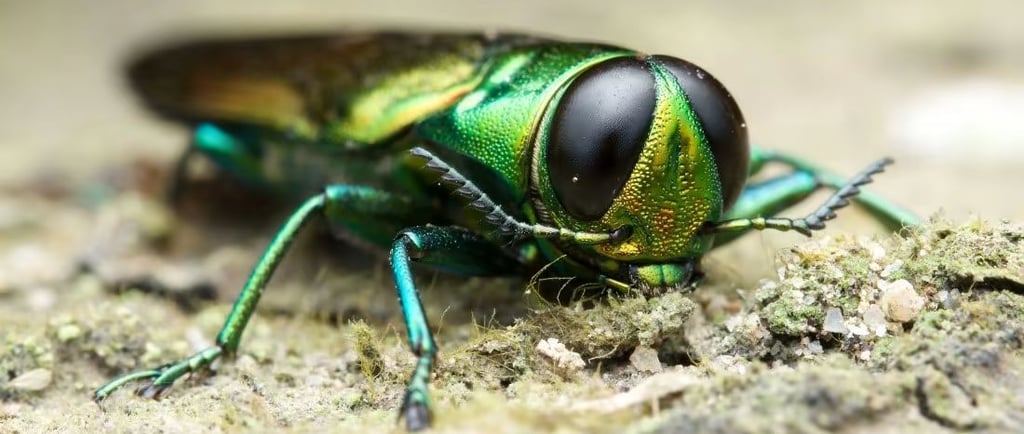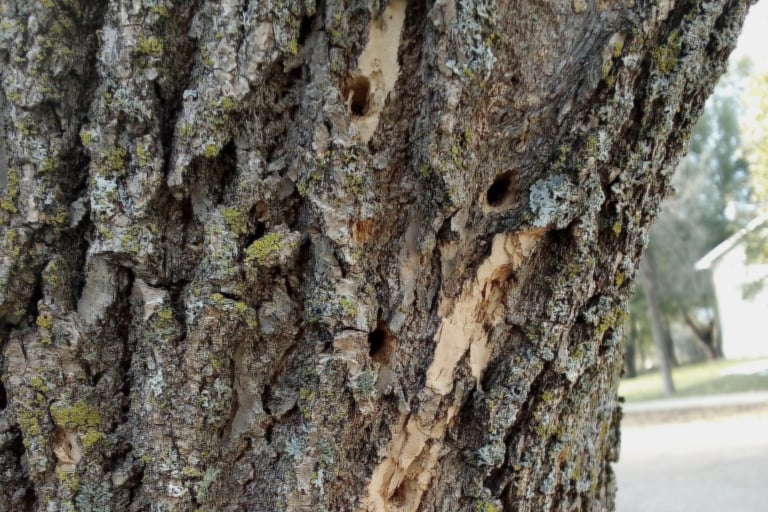The Emerald Ash Borer: Impact and Solutions for Minnesota's Tree Population
The devastating impact of he emerald ash borer beetle on Minnesota's treescape.
KNOWLEDGE HUB
Paul Knigge
6/10/20258 min read


Understanding the Emerald Ash Borer
The Emerald Ash Borer (EAB), an invasive beetle species native to Asia, was first identified in North America in 2002, specifically in Michigan. Since its introduction, this small, metallic green insect has wreaked havoc on ash trees across the Midwest and is now a grave concern for Minnesota's forestry. The EAB primarily targets all species of ash trees, including green, white, and black ash, which are vital components of urban and rural ecosystems alike.
The lifecycle of the EAB consists of several stages: eggs, larvae, pupae, and adults. Adult beetles emerge typically in late spring and lay their eggs in the crevices of ash bark. After hatching, the larvae burrow into the tree, feeding on the inner bark and disrupting the tree’s ability to transport nutrients and water. This feeding initially goes unnoticed but progressively leads to tree decline and potential mortality within a few years. Symptoms of infestation include canopy thinning, unusual sprouting, bark splitting, and the presence of D-shaped exit holes, which are indicative of adult emergence.
As the EAB population spreads, its impact on Minnesota’s tree population is becoming increasingly alarming. The state is home to millions of ash trees, many of which exist in urban areas, parks, and natural forests. The potential consequences of widespread EAB infestation are severe, affecting not just the trees but also the wildlife that depends on them for habitat and sustenance. The loss of these trees can lead to an imbalance in the ecosystem, increased susceptibility to erosion, and diminished aesthetics in residential neighborhoods.
This destructive pest underscores the importance of continuous monitoring, public awareness, and effective management strategies to mitigate its effects on Minnesota's tree population and preserve the state’s ecological integrity.
The Impact on Minnesota's Tree Population
The Emerald Ash Borer (EAB), an invasive pest that targets ash trees, has created significant challenges for Minnesota's tree population. Since its introduction to the state, the EAB has led to severe declines in ash tree numbers, with estimates indicating that millions of trees have been destroyed or are anticipated to succumb to infestations by this beetle. The Minnesota Department of Natural Resources reports that, as of 2023, over 20 million ash trees are at risk across urban and rural areas, underscoring the urgency with which this issue must be addressed.
The ecological ramifications of EAB infestations are profound. Ash trees play a critical role in local ecosystems, supporting various wildlife, including birds and insects. The loss of these trees can disrupt food chains, diminish habitat availability, and ultimately threaten biodiversity. The decline of ash trees can also lead to increased competition for resources among other tree species, thereby altering the composition of forest ecosystems. Communities that once thrived with vibrant urban canopies of ash are now facing a stark reality, where entire streets stand bare of shade and beauty.
From an economic standpoint, the impact of the EAB is equally alarming. Municipalities are grappling with the costs associated with tree removal and replacement, which can quickly exhaust local budgets. Moreover, declining property values in areas heavily affected by EAB can have long-lasting consequences on local economies. The estimated financial burden of the EAB to Minnesota communities is projected to reach hundreds of millions of dollars, factoring in tree replacement and management efforts.
Addressing the EAB infestation is essential not only for maintaining healthy urban areas but also for preserving the overall biodiversity that Minnesota's forests offer. The time to act is now; strategic management and community involvement are crucial to mitigate the lasting effects of this invasive pest.
Preventing Emerald Ash Borer Infestation
The Emerald Ash Borer (EAB) poses a significant threat to ash tree populations in Minnesota, and therefore, implementing effective prevention strategies is essential for homeowners and property owners. One of the primary measures to thwart EAB infestations is to quarantine firewood. Since EAB can easily spread through the transport of firewood, it is vital for residents to refrain from moving firewood from one location to another. Instead, purchasing local firewood and burning it on-site will help mitigate the risk of introducing this destructive pest to new areas.
Another strategic approach is to consider landscaping choices. Property owners can plant pest-resistant trees as alternatives to ash trees. Species such as maples, oaks, and birches not only diversify the landscape but also reduce the overall vulnerability of the area to EAB devastation. These trees require similar care as ash trees but pose a lower risk concerning the spread of EAB.
Regular monitoring is also a critical component in the prevention of Emerald Ash Borer infestations. Homeowners should routinely inspect their ash trees for signs of EAB activity, such as canopy thinning, unusual woodpecker activity, and D-shaped exit holes in the bark. Identifying these indicators early can facilitate prompt action, potentially salvaging affected trees and restricting the pest's spread.
Moreover, fostering community awareness and collaboration is crucial in combating EAB invasions. Neighbors can work together to share information about EAB sightings and educate each other on effective management techniques. Local governments and organizations can play a role in community outreach programs, helping to establish a united front against the Emerald Ash Borer. By prioritizing these preventative strategies, individuals and communities can contribute substantially to the preservation of Minnesota's ash tree population.
Treatment Options for Infected Ash Trees
The Emerald Ash Borer (EAB) poses a significant threat to ash trees, particularly in Minnesota. Once infected, various treatment options are available to property owners to mitigate the damage caused by this invasive pest. Chemical treatments, biological control methods, and consulting professional arborists can all play vital roles in managing EAB-infected trees.
Chemical treatments typically involve the application of insecticides, which can be effective in controlling EAB populations. Products containing active ingredients such as imidacloprid or dinotefuran can be used as soil drenches or trunk injections, targeting the larvae as they feed on the tree. While chemical methods can be quite effective, their use raises concerns regarding environmental impact and safety, particularly around non-target species and nearby water sources. Additionally, the effectiveness of these treatments is contingent upon the timing of application, usually at the start of the growing season when the larvae are most vulnerable.
On the other hand, biological control methods, such as introducing natural predators or parasitoids that target EAB, offer a more ecologically friendly option. This approach promotes a balanced ecosystem and can reduce EAB populations over time. However, the efficacy of biological controls can be unpredictable, and it may take longer to observe results compared to chemical treatments.
Consulting a professional arborist is crucial for property owners faced with EAB infestations. Arborists can provide expert advice on the best treatment options tailored to specific situations and tree health. They can evaluate the extent of damage, oversee chemical applications, or suggest removal of severely infected trees. Ultimately, the choice between these treatment options depends on factors like tree health, environmental considerations, and personal preferences regarding chemical use.
Safe Disposal of Infected Wood
Effective management of wood from trees infected by the Emerald Ash Borer (EAB) is essential in curbing the spread of this destructive beetle. The EAB can survive in ash wood and bark, making improper disposal a significant risk for the contamination of surrounding healthy trees. Therefore, homeowners must adhere to best practices for disposing of infected wood to mitigate this threat.
Local regulations are designed to guide residents on how to safely dispose of EAB-infested materials. Homeowners should first check with their municipalities to understand specific disposal requirements. Generally, it is advised that infected wood and debris are not left in wooded areas or improperly disposed of, as this can facilitate the beetle's spread. Instead, each municipality typically offers designated disposal sites or collection programs specifically for EAB-infested wood.
One of the recommended methods for disposal is chipping the infected wood into pieces less than one inch in diameter. This process effectively kills the larvae and prevents any potential for the EAB to emerge and spread. Homeowners can also burn the wood, when permitted by local ordinances, as this is an effective way to destroy both the wood and any insects within it. If chipping or burning is not feasible, transporting the infested wood to an approved disposal site is crucial. Many communities provide drop-off facilities or special collection events aimed at managing EAB-infested wood.
In addition to these methods, homeowners are encouraged to educate themselves on the signs of EAB infestation and to regularly monitor their ash trees. Maintaining vigilance and promptly addressing signs of infestation can foster healthier landscapes and ultimately contribute to successful management strategies for EAB in Minnesota. By following these established protocols for safe disposal, residents can play a pivotal role in safeguarding their environment and supporting their local tree population.
Responsibilities of Homeowners and Commercial Property Owners
The Emerald Ash Borer (EAB) poses a significant threat to ash trees across Minnesota, necessitating active involvement from both homeowners and commercial property owners. Understanding these responsibilities is crucial for managing the health of the surrounding tree population and ensuring compliance with state regulations.
First and foremost, property owners are responsible for regularly monitoring their trees for signs of EAB infestation. Early detection can help mitigate the spread of this pest. Signs include canopy dieback, woodpecker activity, and the presence of D-shaped exit holes. Homeowners should inspect their ash trees, especially those exhibiting any unusual symptoms. In commercial settings, routine checks should be incorporated into landscaping maintenance schedules to ensure proactive management of tree health.
Additionally, reporting confirmed EAB infestations to local authorities is critical. This allows for coordinated efforts in managing infestations and implementing control measures. Property owners should familiarize themselves with the reporting process in their respective regions, as local governments may have established protocols for addressing EAB cases. Prompt reporting can significantly aid in curbing the pest's spread and minimizing its impact.
Furthermore, adherence to state regulations is imperative for both homeowners and commercial property owners. Minnesota law mandates measures aimed at controlling EAB populations, including the proper disposal of infested wood and compliance with quarantine regulations. Failing to follow these guidelines can lead to fines and contribute to the ongoing deterioration of Minnesota's tree population. Therefore, staying informed about local regulations and updates regarding Ash tree management should be a priority.
In summary, taking a proactive approach in managing ash trees and responding to EAB infestations is a shared responsibility among property owners. Through vigilant monitoring, timely reporting, and adherence to regulations, homeowners and commercial property owners can help protect Minnesota's invaluable tree population. Engaging in these practices not only safeguards individual properties but also supports broader ecological health within the community.
Government Programs and Financial Assistance
The Emerald Ash Borer (EAB) continues to pose significant challenges to Minnesota's tree population, leading to economic and ecological concerns for property owners. In response, various government programs and financial assistance options have been developed to support landowners in managing the impacts of this invasive species. These initiatives are crucial not only for tree removal and replanting but also for promoting overall forest health within the region.
At the state level, the Minnesota Department of Natural Resources (DNR) has established several grant programs specifically aimed at assisting local governments and property owners in dealing with EAB. One such program is the Urban and Community Forestry Grant Program, which provides funding for tree planting initiatives, including the replacement of ash trees that have been lost to EAB. These grants often cover a substantial portion of the project's cost, alleviating the financial burden on individuals and communities.
Additionally, the USDA Forest Service offers cost-share programs that can help defray expenses related to tree removal and replanting efforts. These programs may provide grants or loans to eligible property owners, allowing them to manage their lands effectively while ensuring a healthy tree canopy in their communities. It is beneficial for landowners to actively seek out these programs and comprehend the application processes involved.
Property owners are also encouraged to report EAB infestations to their local extension services. These services serve as a vital link between landowners and available financial resources. They provide expert guidance and connect individuals with the appropriate programs that can assist in mitigating EAB's impact. Engaging with local extension services is an essential step for property owners facing these challenges.
By leveraging government programs and financial assistance, property owners can take proactive measures to address the threat of EAB, ensuring the sustainability of Minnesota's diverse tree population for future generations.




